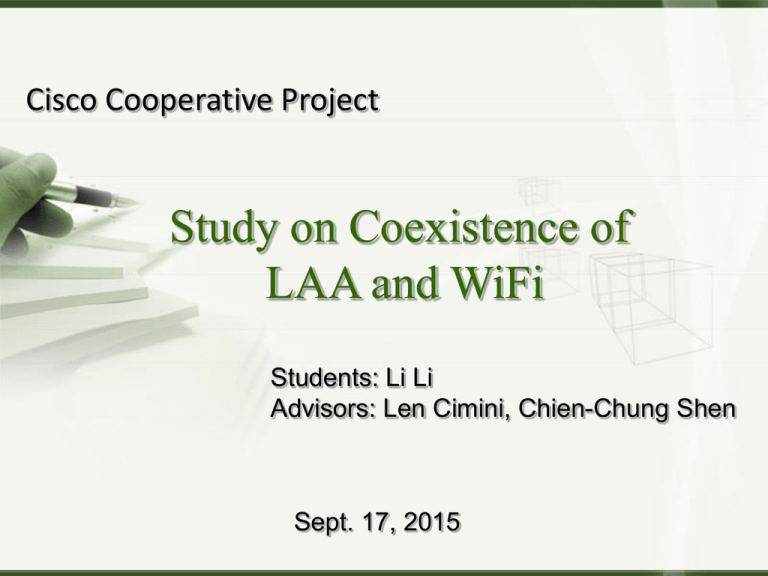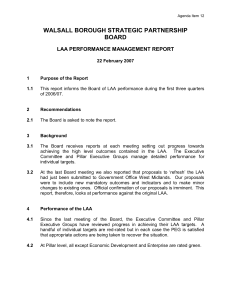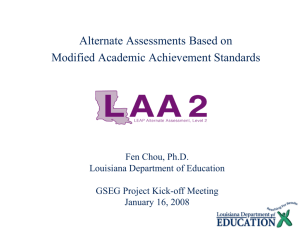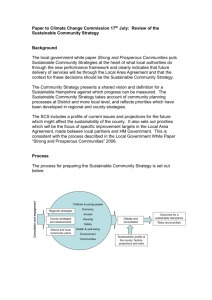Multi-carrier LBT
advertisement

Cisco Cooperative Project Study on Coexistence of LAA and WiFi Students: Li Li Advisors: Len Cimini, Chien-Chung Shen Sept. 17, 2015 Outline Review Simulation Multi-carrier LBT Power sharing for Multi-carrier LBT Next steps 1 Review Simulation: CSMA/CA Random backoff for initial transmission? In general, NO. [1] For a STA to transmit, if the medium is not determined to be busy, the transmission may proceed. A transmitting STA shall verify that the medium is idle for a required duration before attempting to transmit. If the medium is determined to be busy, the STA shall defer until the end of the current transmission. After deferral, or prior to attempting to transmit again immediately after a successful transmission, the STA shall select a random backoff interval. (Section 9.2.2) In general, a STA may transmit a pending MPDU when it is operating under the DCF access method, when the STA determines that the medium is idle for greater than or equal to a DIFS period, or an EIFS period if the immediately preceding medium-busy event was caused by detection of a frame that was not received at this STA with a correct MAC FCS value. If, under these conditions, the medium is determined by the CS mechanism to be busy, the random backoff procedure shall be followed. There are conditions, specified in 9.3.4.3 and 9.3.4.5, where the random backoff procedure shall be followed even for the first attempt to initiate a frame exchange sequence. (Section 9.3.4.2) [1] IEEE Std 802.11TM -2012, “Part 11: Wireless LAN Medium Access Control (MAC) and Physical Layer (PHY) Specifications.” 2 Review Simulation: CSMA/CA Contention window size [1] DS PHY (802.11b): aCWmin = 31, aCWmax = 1023 (Table 16-2) OFDM PHY: aCWmin = 15, aCWmax = 1024 (Table 18-17) Enhanced distributed channel access (EDCA) (Table 8-106 in [1] and [2]) [1] IEEE Std 802.11TM -2012, “Part 11: Wireless LAN Medium Access Control (MAC) and Physical Layer (PHY) Specifications.” [2] https://en.wikipedia.org/wiki/IEEE_802.11e-2005 3 Review Simulation: CSMA/CA Contention window size Voice: Giving voice packets the highest priority enables concurrent Voice over IP (VoIP) calls with minimal latency and the highest quality possible. Video: By placing video packets in the second tier, WMM prioritizes it over all other data traffic and enables support for three to four standard definition TV (SDTV) streams or one high definition TV (HDTV) stream on a WLAN. Best effort: Best effort data packets consist of those originating from legacy devices or from applications or devices that lack QoS standards. Background: Background priority encompasses file downloads, print jobs and other traffic that does not suffer from increased latency. In simulation, FTP traffic model :15-1023, VoIP: 3-7? 4 Review Simulation: Results Simulation setting All nodes are deployed at same location Load rate: 0.5 One pair: one transmitter(eNB/AP) and one receiver(UE/client) q_WiFi = [16,1024], q_LAA = [16,32] M=2 M=4 M=8 WiFi LAA 0.3298 0.3388 0.1917 0.067 8 0.065 7 0.1883 0.2352 0.071 0.0615 0.121 9 7 0.120 8 0.2239 0.121 1 0.121 1 LAAs becomes more and more aggressive as the number of nodes increases. 5 Review Simulation: Results q_WiFi = [16,1024], q_LAA = 32 M=2 M=4 WiFi LAA 0.3332 0.3308 0.2600 0.2609 M=8 0.1673 0.105 0.095 0.095 0.1019 0.091 0 1 9 8 WiFi performs better in this case. 0.1725 0.095 3 0.095 4 0.094 6 q_WiFi = [4,8], q_LAA = [4,8] M=2 M=4 M=8 0.1371 WiFi LAA 0.3333 0.3337 0.1345 0.1354 0.1362 0.034 0.033 0.036 0.0337 0.035 0.035 0.034 5 2 0 2 4 7 High collision probability, leading to ineffective transmission. 0.033 9 6 Review Simulation: Discussion To better coexist with WiFi, LAA needs to change q according to the traffic of WiFi? 7 Review Simulation: Different Locations Simulation setting Single floor building, 4 APs (green) and 4 eNBs (yellow) are equally spaced [1] Transmit power: 18 dBm Load rate: 0.2/0.5/0.8 WiFi: CCACS = -82 dBm, CCAED = -62 dBm; LAA: CCAED = -62/68 dBm q_WiFi = [4,32], q_LAA = [4,32] [1] 3GPP TR 36.889 V13.0.0 (2015-06). 8 Review Simulation: Different Locations Simulation results for different load rates (LAA CCAED: -68 dBm) WiFi LAA R = 0.2 0.166 3 0.166 9 0.165 0.1663 0.166 9 5 0.167 1 0.167 0 0.166 2 R = 0.5 0.301 2 0.123 2 0.184 0.2768 0.318 0 8 0.331 5 0.320 1 0.334 3 R = 0.8 0.360 6 0.111 1 0.184 0.3310 0.383 1 8 0.383 3 0.370 9 0.415 5 The performance is better than the case of same location For WiFi, the nodes in the margin have more opportunities to access the channel than the nodes in the middle For LAA, there is only competition from the closest neighbor (AP) at most of time. 9 Review Simulation: Different locations All WiFi WiFi R = 0.5 0.323 6 0.265 1 0.244 0.3090 0.304 2 4 WiFi 0.264 4 0.227 4 0.302 1 In this simulation setting, LAA has a negative impact on the performance of WiFi. 10 Review Simulation: Discussion All LAA eNBs will be assisted by LTE licensed part. So, with ideal scheduling, there will be no competition among LAA eNBs? 11 Multi-carrier LBT 802.11ac’s channel bonding The backoff procedure is only performed on the primary channel, secondary channel(s) perform a one-shot CCA. Only certain channel bonding configurations are allowed. The designated primary channel should always be part of the channel bonding configurations. 12 Multi-carrier LBT: Option 1 Option 1 (Extended LAA single channel LBT schemes): allow simultaneous transmission on more than one carrier if all of those carriers have completed a full-fledged random backoff and are idle at transmission time. (Intel/Huawei/Qualcomm) The performance depends on the duration of the self-deferral: 1) too short, cannot get large bandwidth; 2) too long, ineffective and may lose the transmission probability. 13 Multi-carrier LBT: Option 2 Option 2 (Wi-Fi like multi-channel LBT schemes): allow simultaneous transmission on more than one carrier if one of those carriers has completed a full-fledged random backoff and others are found to be idle before transmission for at least the duration of 25 us. (Bell, Erricsson) Additionally configuring a “primary channel” on unlicensed spectrum for LAA like 802.11ac may result in the transmitter failing to access other carriers when the “primary channel” is blocked. The LAA device can also dynamically perform independently eCCA procedure on all unlicensed carriers and select the carrier which first completes the eCCA as the “primary channel” to allow fast channel aggregation. 14 Multi-carrier LBT: Results by Ericsson Both Option 1 and Option 2 coexist with WiFi very well. 15 Power Sharing for Multi-carrier LBT LAA operation in the 5GHz band is subject to a total transmit power and per MHz PSD constraint on the entire bandwidth available in each band. Different from current LTE, where there is no constraint on the total power per operating band. For example, a total of 23dBm transmit power is allowed in the 5150MHz to 5350MHz. A 20MHz LAA transmission can utilize the entire 23dBm power on a single carrier. A 40MHz splits the power between the two 20MHz carrier and an 80MHz transmission has to between 4 20MHz carrier. 16 Power Sharing for Multi-carrier LBT Option 1: Fixed and equal maximum power allocation per carrier Option 2: Fixed and unequal maximum power allocation per carrier Performance loss when only a few carriers are aggregated for transmission. Option 3: Dynamic maximum power allocation between carriers at least based on the number of carriers being transmitted in each DL transmission burst A conservative CCA threshold has to be used for each carrier which reduces the chance of CCA success. Reference signal power vary each time, a problem for RSSI measurements and CSI reporting etc. It is beneficial to explicitly indicate the transmission power of each burst to UEs dynamically. 17 References [1] Qualcomm, “R1-153875, Multi-carrier operation for LAA,” Aug. 2015 [2] ZTE, “R1-154074, On LAA RRM measurement and carrier selection,” Aug. 2015 [3] Intel, “R1-154079: Multi-carrier LBT,” Aug. 2015 [4] Intel, “R1-154087: On the dynamic power sharing among multiple LAA SCells for DL-only transmission,” Aug. 2015 [5] Samsung, “R1-154137: LBT procedure for multiple-carrier transmission,” Aug. 2015 [6] Huawei, “R1-154342: Multicarrier operation for LAA DL,” Aug. 2015 [7] Alcatel-Lucent Shanghai Bell, “R1-154573: Multi-carrier LBT operation for LAA,” Aug. 2015 18 Multi-carrier LBT: channel selection 19 Next steps Simulate the coexistence of 802.11ac with CB and LAA with multi-carrier LBT Continue to study channel selection algorithms 20



